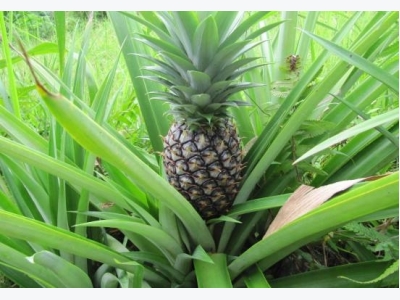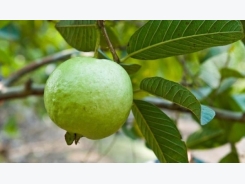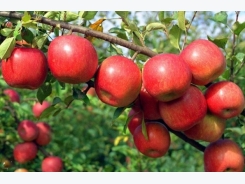Pineapple Cultivation Information Guide

Introduction of Pineapple Cultivation:- Pineapple is a tropical and sub-tropical plant with edible fruit consisting of coalesced berries, also called pineapples. Pineapple is one of the commercially viable and profitable fruit crops of Asia and other parts of world. Growing of pineapple originated in Brazil and gradually spread to other tropical parts of the world. Pineapple belongs to the family of “Bromeliaceae”
Pineapples can be grown for edible purpose and production of fiber. Pineapple fruit can be consumed fresh, cooked, juiced, or preserved. When it comes to plant description of pineapple, it is an herbaceous perennial, which can reach up to 1.5 to 1.6 meters height. In appearance, the pineapple plant has a short, stocky stem with tough, waxy leaves. Commercial grower’s proper orchard management practices can achieve good profits as it has an excellent demand in local and international markets. Pineapple can be grown in pots, containers and indoors.
Scientific Name or Botanical Name of Pineapple:- Ananas comosus.
Genus of Pineapple:- Ananas.
Family Name of Pineapple:- Bromeliaceae.
Pineapple Names in Other Parts of World:- Pynappel(Afrikaans), Ananas(Dutch), Ananas(German), Хан боргоцой( Mongolian), Ananas (Polish), Anann (Scotish), Cananaaska (Somali), Anaanas(Urdu),Ananasi(Albanian),Ananas(Bosnian),Pinya(Cebuano),Ananass(Estonian),Aνανά/Ananá(Greek ),painaepeul/파인애플(Korean), BhuinKatahar(Nepali),Ananas(Maltese),Ananás/Ananáz(Portuguese), Ananas(Serbian), Piña(Spanish), Ananas(Uzbek), ananaas/أناناس) Arabic), Ананас/Ananas (Bulgarian), 菠萝 (Chinese), Pinya (Filipino), Ananas(Italian), Ananas (Norwegian), Saparo(Thai), Dua (Vietnamese), Arkayakhntsor(Armenian), パイナップル/Painappuru(Japanese), Ananasu (Latvian), Ananas(Romanian),,Ananas(Czech),An anas(French), Ananas(Macedonian),Ananas(Swedish),Ananas(Turkish),ანანასის(Georgian),Ananász(Hungarian),Nanas(Malay),ānānās(Persian),अनानासम्(Sanskrit),onglaai(Taiwanese). Pineapple Names in India:- Pineapple (English), Ananas (Hindi), Anasi Pazham / Parangi Thalai (Tamil), Kaitha Chakka (Malayalam), Ananas(Kannada), Anarash (Bengali), Ananas (Gujarati), Anas / Aambo (Konkani), Ananas (Marathi), Supuri Anasianas / Sapuri (Oriya), Kihom(Manipuri), আনাৰস (Assamese), Ananas (Punjabi), Punchitipul(Kashmiri), Parengi Pelakai (Tulu), Anasa Pandu (Telugu).
Top Ten Production Countries of Pineapple:- The following are top ten production countries of Pineapple in the world
- Philippines
- Thailand
- Costa Rica
- Indonesia
- Chile
- Brazil
- India
- Nigeria
- Mexico
- Colombia.
Health Benefits of Pineapple:- The following are some of the health benefits of pineapple.

Health Benefits of Pineapple.
- Pineapple fruit is a good source of vitamin ‘A’,’B’, ‘C’ and calcium, magnesium, potassium, iron.
- Pineapple is good for digestion.
- Pineapple has cancer prevention properties.
- Pineapple has antioxidant properties and good for eye and skin health.
- Pineapple has anti-inflammatory properties.
- Pineapple is good for heart health.
- Pineapple boosts the immune system.
- Pineapple is good for asthma prevention.
- Pineapple is good for tissue and cellular health.
- Pineapple can increases fertility.
- Pineapple is good for bone strength.
Varieties of Pineapple:- There are many improved cultivars (varieties) of pineapple grown specific to the region. However, the popular commercial varieties of pineapple are; Pernambuco, Queen Victoria, Giant Kew, Mauritius, Smooth Cayenne and Red Spanish.
Climate Requirement for Pineapple Cultivation:- Pineapple fruits grow well near the sea coast as well as in the interior as long as the temperatures are not extreme. The optimal or ideal temperature range required for pineapple cultivation is 22 to 34°C.The ideal rainfall should be well distributed throughout the year and more than 700 mm per year. Extreme temperatures will result in low yield due to sunburn. Frost free conditions are best for its cultivation.
Soil Requirement for Pineapple Cultivation:- A light well drained soil with good organic matter having pH 5.5 to 6.5 is highly recommended. Heavy soils can also be used for commercial cultivation in case of well- drained soils. Commercial growers can go for soil test and supplement any nutrient deficiency based on soil test results. Make sure to have well drainage as poor drainage leads to a weak root system, which makes the pineapple plants more susceptible to root rot diseases. Addition of farm yard manure will result in more produce/yield.
Land Preparation in Pineapple Cultivation:- Land can be prepared by giving couple of ploughings or digging followed by levelling. Any trees from previous crops should be removed. Make sure the land is free from any stones and weeds. Trenches of convenient length, width and depth should be prepared depending on nature of land.
Propagation in Pineapple Cultivation:- The recommended propagation method of pineapple plants is by planting crowns (or “tops”), slips or suckers. They can even be propagated through seeds. If the pineapple planting is done by propagation method of suckers, one can expect the harvest of fruits in 16 to 17 months, in case of slips propagation, the harvest would be in 19 to 20 months and where as in crowns propagation, the fruit harvest time period would be in 22-25 months.
Season for Pineapple Sowing:- Time of planting also varies from place to place depending upon the time of onset of the monsoon and the intensity of its precipitation. As long as irrigation facility is available, they can be grown throughout the year.
Treatment of Planting Material in Pineapple Cultivation:- Planting material should be treated before planting to prevent from diseases (bud rot.) . Planting material should be dipped in 0.2 % Dithane M-45 before planting to protect the plants or ceresan solution (4 grams in 1 liter of water).
Planting and Spacing Pineapple Cultivation:- Different planting methods can be adopted in pineapple cultivation such as flat-bed, furrow, contour and trench. The method of planting depends on land and rainfall. In the slopes, terracing or contour planting is adopted which helps to check soil erosion. Well, some growers use double rows, others 3 rows or more. However, pineapples are generally planted in double rows spaced at 2 feet between the rows, 1 ft. between plants and 4 feet between adjacent double rows. This gives an approximate plant density 36,000 to 36,250 plants/ha. Commercial farmers can adopt high density plantation in which more yield can be achieved.

Pineapple Plantation.
Irrigation in Pineapple Cultivation:- Timely irrigation is very important to get good yields in any fruit farming. Pineapple plants are sensitive to saline irrigation. This results in yields reduction, if the irrigation water’s electro conductivity is greater than 1.29 ds/m. As pineapples are grown as rainfed crop, irrigation should be provided in dry hot climatic conditions. Irrigation may be provided once in o 4 weeks. Drip irrigation can be adopted for proper water utilization in areas where water is major problem.
Manures and Fertilizers in Pineapple Cultivation:- Any required nutrients or micro-nutrients should be added as part of land preparation after getting soil test results. Nitrogen plays major role to increase of fruit size and total yield of the crop. Well-decomposed farm yard manure (FMY) of 45-50 tonnes/ha should be supplemented. When it comes to N,P,K; 16 grams of ‘N’, 4 grams of ‘P’ and 12 grams of ‘K’ should be applied in 2 equal split doses at 6th and 12th month after planting the crop. To prevent the deficiencies in the early crop phase, a foliar spray 0.5%-1.0% sulphate of Zinc and Ferrous solutions should be applied at 2 weeks interval.
Pruning in Pineapple Cultivation:- Pineapple plants have large leaves that may need pruning (trimming) to control sprawl, and you can safely prune the ground suckers.
Mulching in Pineapple Cultivation:- Mulching can be done to control the weeds, prevent moisture loss from the plant base. It is also useful in preventing from soil erosion. In pineapple cultivation, mulching material like grass, straw, black polythene and saw dust, dry leaves or chopped debris from previous pineapple crops may be used.
Weed Control and Intercultural Operations in Pineapple Cultivation:- Well, weed control is major task in any fruit crop that influences the yield and quality of produce. Weeds can be controlled in three ways by hand, using mulch and herbicides. Manual weeding in pineapple cultivation is difficult and expensive.
Weeding should be done at least 4 to 5 times in a year. One can carry out mulching in pineapple farming in order to control weeds and prevent from moisture loss. Apart from manual weeding and mulching; herbicides can also control the weeds. Perennial weeds in pineapple plantation should be dug out prior to planting and all newly germinating weeds should be controlled while in seedling stage. Mulching material like grass, leaves or other organic materials such as chopped debris from previous pineapple crops can be used. Pre-emergence herbicides like HYVAR-X (Bromacil) should be applied soon after planting and the crop remains weed-free for about 12 months. Post-emergence herbicides like GESAPAX and GESATOP should be applied when the weeds are growing actively. Care should be taken when using manual weed removal as the pineapple plants have shallow rooted system. Earthing up should be carried out in pineapple cultivation aimed at good anchorage to the plants. Soon after harvest, earthing up should be leaving one to two suckers only.
Growth Regulators in Pineapple Cultivation:- Growth regulators can be used to induce flowering and increase fruit set in pineapple cultivation. You can find out with horticulture department for appropriate growth regulators for pineapple production.

Growing Pineapple in Container.
Pests and Diseases in Pineapple Cultivation:-
Pests and Their Control Measures in Pineapple Cultivation: Pineapple is usually free from most of the pests except mealy bugs and scale insects. However, Mealy bugs can be controlled by spraying Methyl Demeton 2 ml/liter of water.
Diseases and Their Control in Pineapple Cultivation: No serious diseases are found in pineapple cultivation except stem rot. This can be controlled by providing good drainage and dipping the suckers in Boradeaux mixture before planting in the field.
Sun Burn: During hot summer months, it is essential to protect the fruits from scorching sun by placing dried grasses, coconut or arecanut leaves.
Note: Your local horticulture department is good source for finding suitable solutions for controlling pests and diseases in Pineapple Cultivation.
Harvesting in Pineapple Cultivation:- Generally pineapples should mature in 16-24 months after planting depending on the planting material used for cultivation. As part of harvesting, it is best to cut, rather than to break the pineapple fruit by the stalk. Harvesting should be done with a sharp knife with a clean cut and retaining 5-6 cm of the stalk. Slight colour change at the base of the fruit indicates maturity stage.
Yield in Pineapple Cultivation:- Well, yield of any horticulture crop depends on many factors such as verity grown, age of plant or tree, soil type, agro-climatic conditions and orchard management practices. In pineapple cultivation, an average yield of the main crop should be about 70-75 tonnes/ha, while ratoon crops are about 50-55 tonnes/ha. In-case of high density planting of pineapple, yield would be more.
Ratoon cropping in Pineapple Cultivation:- The plant crop after harvest can be retained as ratoon crop for 2 more years. After the harvest of the plant crop, chopping the side leaves of the mother plant should be done for easy cultural operations. The suckers retained should be limited to 1 or 2 per mother plant. Any excess suckers should be removed from the plant. Earthing up should be carried put and other management practices and intercultural operation are same as for the plant (main) crop.
Post-Harvest Management in Pineapple Cultivation:-The following are the main tasks of post-harvest management of pineapple production.
Grading: Pineapples should be graded on the basis of their size, weight and colour.
Storage: Usually, pineapple with crown can be kept without damage for 10-14 days after harvesting. When fruits require long distance transportation, make sure to provide refrigerated transport to slow down ripening process. Pineapples can be stored well for a period of 20 days when refrigerated at 10°C- 13°C. The best storage can be achieved at the temperature of 7.0°C and 80 or 85% relative humidity.
Packing: Pineapple can be packed in bamboo baskets for local markets where as for distant markets; pineapples can be wrapped individually with paddy straw and then packed.
Transportation: Road transport by trucks or vans is the most common method of transporting fruits to local markets from orchard.
Marketing of Pineapple:- If the fruits are grown on large scale, a well prepared marketing plan should be established before getting the crop matured. The commercial growers usually sell the produce at the farm gate to the middlemen or transport to local market.
Related news
Tools

Phối trộn thức ăn chăn nuôi

Pha dung dịch thủy canh

Định mức cho tôm ăn

Phối trộn phân bón NPK

Xác định tỷ lệ tôm sống

Chuyển đổi đơn vị phân bón

Xác định công suất sục khí

Chuyển đổi đơn vị tôm

Tính diện tích nhà kính

Tính thể tích ao



 Capsicum Cultivation (Bell Pepper) Information Guide
Capsicum Cultivation (Bell Pepper) Information Guide  Gooseberry Farming (Amla) Information Guide
Gooseberry Farming (Amla) Information Guide